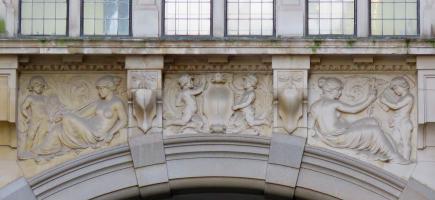
The principal frieze, Drapers' Hall, Throgmorton Avenue.
The principal frieze, Drapers' Hall, Throgmorton Avenue. 
The best known bit of the exterior of Drapers’ Hall is to Throgmorton Street, where there are two giant atlantes (male figures supporting architecture in place of pillars) wearing turbans, but the rear of the building, to Throgmorton Avenue, has interesting sculpture in high relief. The building is best approached from the north, through a gated passage from London Wall - see picture below left. Walking down the short passage, then, the view is terminated by the red brick and white stone narrow building over a broad arch - see below right. There are several bands of sculpture, four in all, plus the rounded Queen Anneish pediment at the top. Apparently the building dates from the 1870s, though I would think that this part dates from much nearer the end of the century, or at least the sculpture would seem to.
Throgmorton Avenue, and rear of Drapers' Hall. 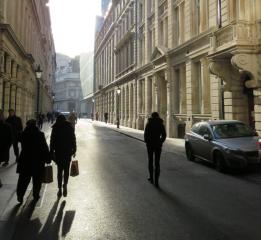
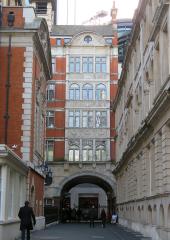
The principal sculpture is the lowest, over the broad arch to Throgmorton Street. We have three panels over the arch, separated by the supporting brackets to the windows above. The smaller central panel has two plump, naked putti supporting a cartouche, and we need not linger there. It is the two side panels which are more interesting, eachwith a group consisting of a semidraped girl seated on the curve of the arch – we can almost call them spandrel girls – and another of those putti, standing. To the left, the girl is a young shepherdess, holding her crook over one shoulder, lounging relaxedly and staring a little downwards. Her upper body is bare, and her hair is caught up at the back of the head to leave her neck and shoulders exposed. Very sweet. Confronting her is that putto, hand on hip holding a sickle, his other arm holding a sheaf of corn, and with his stomach thrust out somewhat unpleasantly. So overall the group can be taken as representative of Agriculture (see this page for more allegorical sculpture of Agriculture). The female figure on the other side, to the right, is reversed for compositional variety, so we see her back. Otherwise, she is of similar look and feel to her sister to the left. In her one extended hand she holds a Caduceus – a winged staff with two snakes entwined round it – which is generally a symbol of travel, or trade (see this page for more snake sculpture and the cadaceus). The latter interpretation seems most likely here, as the putto facing her, here in profile, carries a parcel over his shoulder - click to enlarge to see the detail.
Allegorical figure sculpture: Agriculture, heraldic arms, Trade. 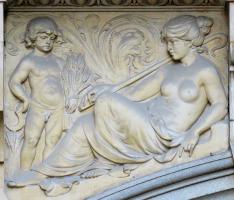
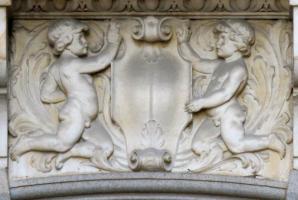
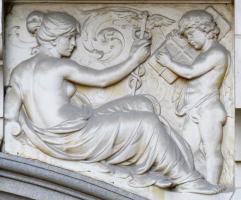
The windows above contain stained glass, and above those are the next band of sculpture, a proper frieze straight across. It is a symmetrical and repeating composition of four putti, unclothed again, holding garlands of flowers between them, each garland in front of a broad, scrolly tapestry carved in low and higher relief. The use of putti is likely related to the wish to have figure sculpture in proportion to the height of the frieze, without having figures of adult proportions where little could be seen from down below; thus an overall decorative effect rather than a concentration on the figures themselves, unlike in the lower and more accessible sculpture.
Now the convention is that as we go upwards, the bands of sculpture become simpler, again in part because the detail can be seen less well from down below. So the next frieze is a scroll and strapwork design, with central shield, a few carved fruits, and a tendancy to leafiness.
Upwards again, and on the uppermost frieze, there is a blank central panel, more strapwork to the sides, with two Renaissance-style griffins to the sides, and more drapery and leaves and a bit of fruit – the whole is reminiscent of ornamental engraved book headpieces and tailpieces. By now we are really mostly in lower relief, with just the fruit sticking forward. It seems that in the interest of the low relief decoration, the idea of what level of detail could be seen from below is somewhat lost.
Finally, at the very top, is a curved pediment or gable, call it what you will, with a round central window, and around it and to the sides more scrolly, leafy space-filling carved ornament, and incorporating two grotesque animal heads, bears perhaps, emerging from the scrolling and with lengthened lower jaws. Grotesque in this context refers not to ugliness (though they are really not beautiful), but to the subsidiarity of the representation of the animal to the ornamental purpose. And yet the nature of the design overall, with the more vigorous and heavy scrolling, undercut to give a contrast of light and shade, is more suitable for the height than the two levels below, in terms of what can actually be seen without visual aid.
Atlantes figures for Drapers' Hall by the sculptor H.A. Pegram. 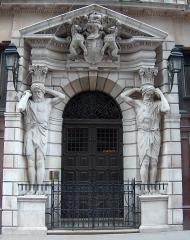
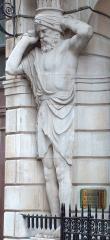
After all this, we can walk through underneath the arch to see the front entrance of Drapers’ Hall, with those Atlantes to each side. These powerful, splendid figures are known to be by the sculptor Henry Alfred Pegram, and date from 1896, applied onto the older underlying gateway; I would think that the sculpture we have looked at on the reverse of the building dates from this time too. Is the sculpture on the back of the building actually by Pegram? It could be – he did make cherubic figures not dissimilar to the putti here, but that pair of girls, so round of face and breasts, are not characteristic of his work that I have seen.
Putti frieze, Drapers' heraldic arms, view along Throgmorton Street. 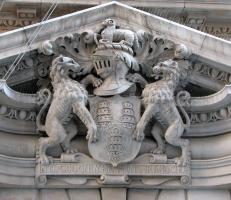
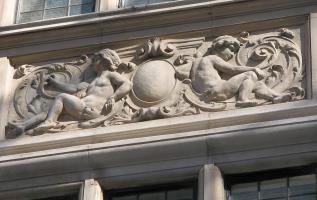
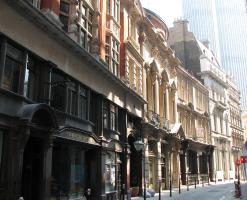
Throgmorton Street, it should be mentioned, is named after Sir Nicholas Throckmorton, whose noble effigy may be seen reclining nearby in the City Church of St Katharine Cree, along with other good things. We might note in passing that the original spelling of Throckmorton has been resurrected in a more recent road in the Royal Victoria Docks downriver (a Gresham Road is adjacent); however I understand that the American streets by this name were named after a 19th Century figure.
Once in Throgmorton Street, turning to the west, the street becomes Lothbury, leading us past one side of the Bank of England and with various decorative sculpture to be seen, as well as another City Church, that of St Margaret Lothbury.
Cadaceus and shepherd's crook, details. 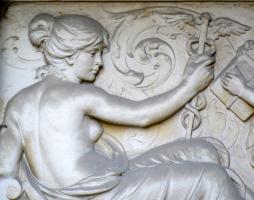
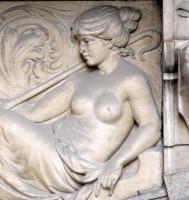
Back to Sculpture of the Month for February // Onward to April
East to St Helen Bishopsgate // and then South to St Andrew Undershaft // or South to St Mary Woolnoth // or West to St Alban Wood St
Visits to this page from 1 Mar 2017: 4,422